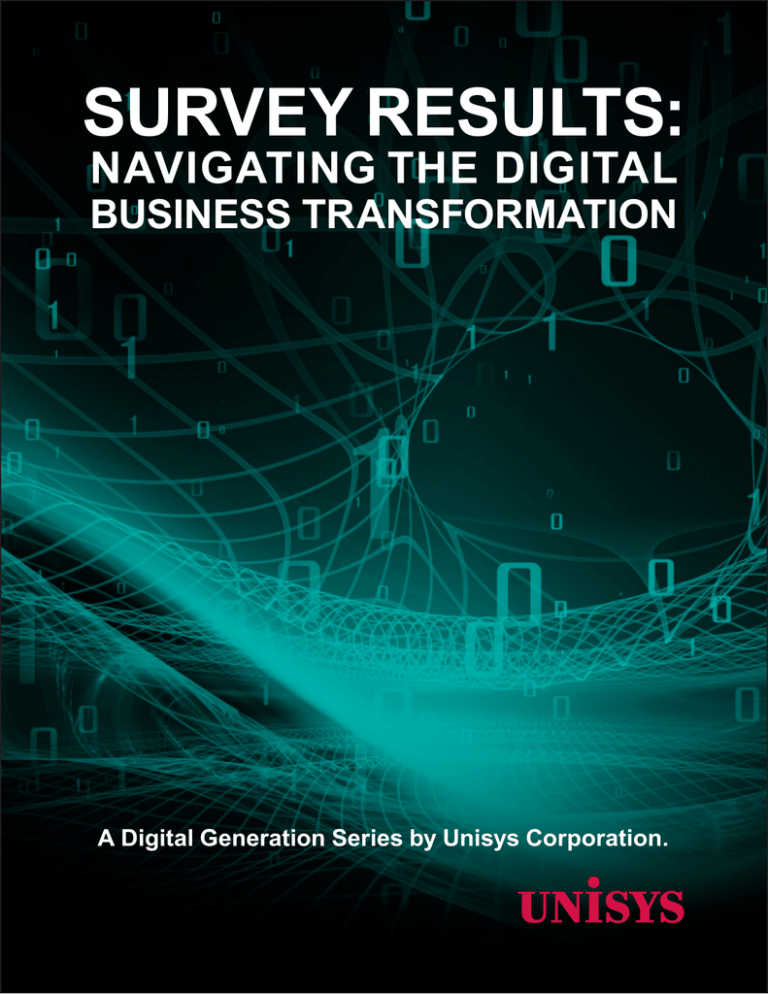
SURVEY RESULTS:
NAVIGATING THE DIGITAL
BUSINESS TRANSFORMATION
A Digital Generation Series by Unisys Corporation.
1.
IT and Business Executives Tell Unisys/IDG They Understand the Value of
Adopting a Digital Business Model— But Still Struggle for a Solution
It never stops: Another year, another new IT challenge. According to a new survey of 188 global
IT executives conducted by Unisys and IDG Research, IT’s biggest challenge in 2016—cited by
55% of respondents—is providing high levels of service to increasingly tech-savvy customers and
employees.
IT executives recognize those levels of service are crucial to transforming the enterprise into a
digital business, defined as “the convergence of social, cloud, mobility, data analytics, and security
to drive new business models and engage, enable, and support an increasingly tech-savvy workforce and customer base.”
Nearly two-thirds of respondents (65%) to the Unisys/IDG survey consider it highly important for
their organizations to modify technology, IT processes, or IT resources over the next 12 months to
support a digital business model. The top driver for prioritizing the digital business evolution: The
ability to enable innovation and create new business opportunities across multiple regions, cited by
35% of respondents. The second-highest priority, cited by 30% of respondents: The need to keep
pace with customer expectations.
The value of adopting a holistic digital business model is clear: Many enterprises face competition
from start-ups that not only aren’t hampered by legacy infrastructure, but also use new, highly
flexible IT infrastructures. As a result, these nimbler competitors can respond quickly to customer
demand and spot new, emerging opportunities as they arise.
No matter what the industry, companies that grasp the stakes and understand the true potential of
“going digital” have a much better chance of coming out ahead than others. So what does enterprise IT need to know?
Recognizing the Potential
IT decision makers need to understand that while the two constituencies that digital business
serves—customers and end users—are different, both groups want to access information quickly
and easily. Whether it’s account information, purchase records, or product specs, the data should
be easy to find and even reconfigure if users require a different view.
Creating the digital business is not only, however, a question of simplifying access to data. There
are other, more critical reasons for focusing on the digital transformation. Data access, and
access to the insights that data analytics offers, can be used to improve the customer experience,
increase engagement, and provide competitive differentiation.
In addition, by drawing on and integrating information from the entire organization, a digitized
business delivers cross-business insight. This logical integration of data can produce the knowledge necessary for developing new revenue streams, accessing new markets, or evolving the user
interface, for example.
Are We There Yet?
The Unisys/IDG survey indicates that organizations are still well short of becoming true digital
businesses. The problem is the gap between reality and desire. Getting started, for instance, is a
key obstacle. Take the issue of increasingly high customer and end-user expectations. More than
half of respondents (52%) report that end-users want more accessible and searchable data. Those
same end-users also expect better integration and support of data analytics tools (cited by 48%
of respondents). In order to deliver on those mandates, IT needs to provide better data integration
between onsite and cloud applications and data (cited by 43%).
2.
But most enterprises just aren’t there yet. Less than half (45%) of respondents rate their organization’s progress as above-average when it comes to supporting end-user expectations and the
demands associated with creating a digital business model. Only a third (32%) report average
progress, and 22% consider their progress below average.
The survey defined five key components of a digital business: mobile application development,
cloud deployment, social media, data analytics, and security. Among respondents who rate each of
these five initiatives as a critical or high priority, less than 20% report significant progress in any one
area. Worse, few respondents indicate their organization is ready to meet customer expectations
over the next 12 months. Only 41% indicated that their technology or infrastructure was prepared,
while 40% rated their IT skill sets as adequate and 39% rated their security and compliance strategy
as adequate.
Among those who consider each of the five digital business initiatives as at least a moderate
priority, respondents report the most progress in only two of the five key areas. Sixty-nine percent
(69%) cited at least some progress in both mobile application development and cloud deployment,
but are paying less attention to social media, data analytics, and security. Overall, according to
respondents, organizations struggle the most with IT automation (cited by 26%), the end-user
experience (34%), and customer experience (35%).
Interestingly, respondents in EMEA are focusing on different issues. They are significantly more
Top IT Challenges for 2016: Meeting End User Demands and Expectations
Making data more accessible
and searchable
Integration and support of data
analytics tools
Integration of on-premise and cloud
applications and data
Support of corporate-owned and
personally enabled devices
52%
50%
58%
48%
45%
56%
43%
41%
50%
37%
37%
38%
Mobile app development and support
36%
32%
46%
Support of personally owned devices
(BYOD)
32%
31%
36%
Gaining a 360-degree view of
customers/clients
Implementation of
self-service/self-help tools
Improving the ability to quickly locate
and collaborate with colleagues
Other
31%
28%
42%
30%
27%
38%
29%
26%
38%
4%
4%
2%
n All respondents
n US
n EMEA
3.
likely than their U.S. counterparts to rate developing an IT service catalog and service management system as highly important (48% vs. 30% in the U.S.). They are also more likely to focus on
taking advantage of the Internet of Things (52% vs. 31% in the U.S.). Both service catalogs and the
Internet of Things are important digital tools for collecting and integrating information from multiple
parts of the enterprise. They are also valuable for modifying the IT and customer-facing processes
required for digital business transformation.
Avoiding Complacency
Overall, IT departments and the enterprise can’t afford to be complacent. Nor can they continue
doing things the way they have up until now. Too often, IT departments update systems with an
18-to-24-month schedule. In today’s digital era, changes come faster than that—sometimes in less
than a year—and new digitized competitors have a much shorter time-to-market.
Enterprises simply aren’t as agile as they need to be to function as digital businesses. What’s
more, their efforts to do so could be hindered by a human-capital issue: 38% of respondents to the
survey say that they struggle to attract and retain a skilled IT workforce. Solving these issues can
open up new opportunities and allow companies to be more competitive.
However, IT recognizes that, as the saying goes, the ideogram for crisis and opportunity are the
same. The IT organization stands on the brink of considerable opportunity to help change corporate strategy. Respondents understand the importance of the digital business as well as the imperative to measure their success. Improvements in IT efficiency (cited by 47% of U.S. respondents)
and improved user experience (cited by 45% of U.S. respondents) are top success metrics. EMEA
respondents take a different view of the opportunity. Forty-six percent (46%) indicate their organizations rely most heavily on improved infrastructure performance/availability to measure success
with end-user support. In reality, improvements in all three can have symbiotic and positive impact.
Where there’s progress, it’s in the right direction. A strong majority—70% of respondents’ organizations—are delivering persona-based service to support internal IT users (and another 15% of
respondents would like to do so). Persona-based services are personalized to the job or service
requirements of a specific role, rather than a specific individual; that way, if an employee transfers
out of finance, for example, they don’t retain security access to proprietary financial information.
Persona-based services extend the principles of customer relationship management (CRM) that
normally apply for external customers to internal users. The premise is simple: A better understanding of needs and behaviors leads to better service (and service management). Respondents
Less Than Half of Organizations Rate Their Progress Supporting End
User Expectations and Demands as Above Average
Above average
39%
Average
32%
Well above average
Don’t know
1%
6%
5%
Below
average
17%
Well below average
4.
How Unisys Can Help
The components of a digital business strategy that serves both customers and employees are clear-cut. Enterprises need
to collect, analyze, store, and protect data. Unisys brings a focus to each of these areas, whether it’s collecting data from
social media sources on mobile devices, storing data in the cloud, conducting data analytics, creating persona-based
end-user support services, or protecting data with the highest levels of security.
What’s more, Unisys is an expert in integrating all these capabilities, helping enterprises not only create digital businesses,
but also create digital businesses that are noteworthy for their automation and agility. After all, competitive pressures—like
technology—always change and evolve. Unisys helps companies create systems to address digital business challenges
this year—and beyond.
Find out how Unisys can help you create your digital business through innovation and agility. Contact us at DigitalGen@
unisys.com and more at our digital generation resource center.
to the Unisys/IDG survey note that they are focusing on this departmentally, rather than holistically,
which makes sense; employees in different departments (and indeed, even new customers versus
established customers) should have different personas when it comes to security and access. A
new customer should have a different persona than an established one; the difference may relate
to credit limits or other privileges, for example.
The question really becomes, how can IT departments and businesses work together to achieve
success faster? How can they realize the best results for the most economic investment? How can
they measure their success and make adjustments as they move forward?
Getting There From Here
What’s next for enterprises? There are three things to consider:
1 E
nterprises need to identify, based on corporate strategy, which departments will benefit the
most from a holistic digital business strategy.
2 T
hey must start creating systems that digitally enable their customers and employees as a
whole, not just by isolated business units.
3 E
nterprises must learn from the successes (and missteps) of those efforts to continue making
progress across the enterprise. Part of moving faster and responding more quickly means
understanding when a project isn’t going to fulfill its ambitions, cutting losses, and moving
forward in a different direction.
Most businesses are attempting digital transformation today, but few have adopted or mastered
the digital business model to a point of competitive differentiation. However, enterprises that target
even small improvements can find success (after all, calling Uber isn’t that different than calling a
cab). It’s simply a matter of thinking about what data might be useful or even available—and how it
can be turned into opportunity.
Take the experience of one global food manufacturer with a division selling ice cream. The fact that
consumers buy more ice cream when it’s hot seems obvious, but this manufacturer sensed that
anticipating temperature spikes and heat waves offered an opportunity. The company analyzed
weather patterns and increased ice cream deliveries to retailers when temperatures went up. The
result: a 60% growth in sales.
That’s just one example of using data analytics to improve sales. It demonstrates that even though
the transformation to a digital business is challenging, it can have bottom-line impact, and should
be viewed as an opportunity rather than a challenge. The time is now to face this change head
on with the technological tools available. It’s time for savvy enterprises to take their place in the
vanguard, not among the followers.
5.
Find out how Unisys can help you give digital generation workers the
solutions and support they want, without sacrificing control, visibility
or security.
Contact us at DigitalGen@unisys.com and learn more at our digital
generation resource center.
WWW.UNISYS.COM/GENERATIOND
About Unisys
Unisys is a global information technology company that works with many of the world’s
largest companies and government organizations to solve their most pressing IT and business challenges. Unisys specializes in providing integrated, leading-edge solutions to clients in the government, financial services and commercial markets. With more than 20,000
employees serving clients around the world, Unisys offerings include cloud and infrastructure services, application services, security solutions, and high-end server technology.
© 2016 Unisys Corporation. All rights reserved.
Unisys and other Unisys product and service names mentioned herein, as well as their respective logos, are
trademarks or registered trademarks of Unisys Corporation. All other trademarks referenced herein are the
property of their respective owners.
Printed in the United States of America 1/16
6.



